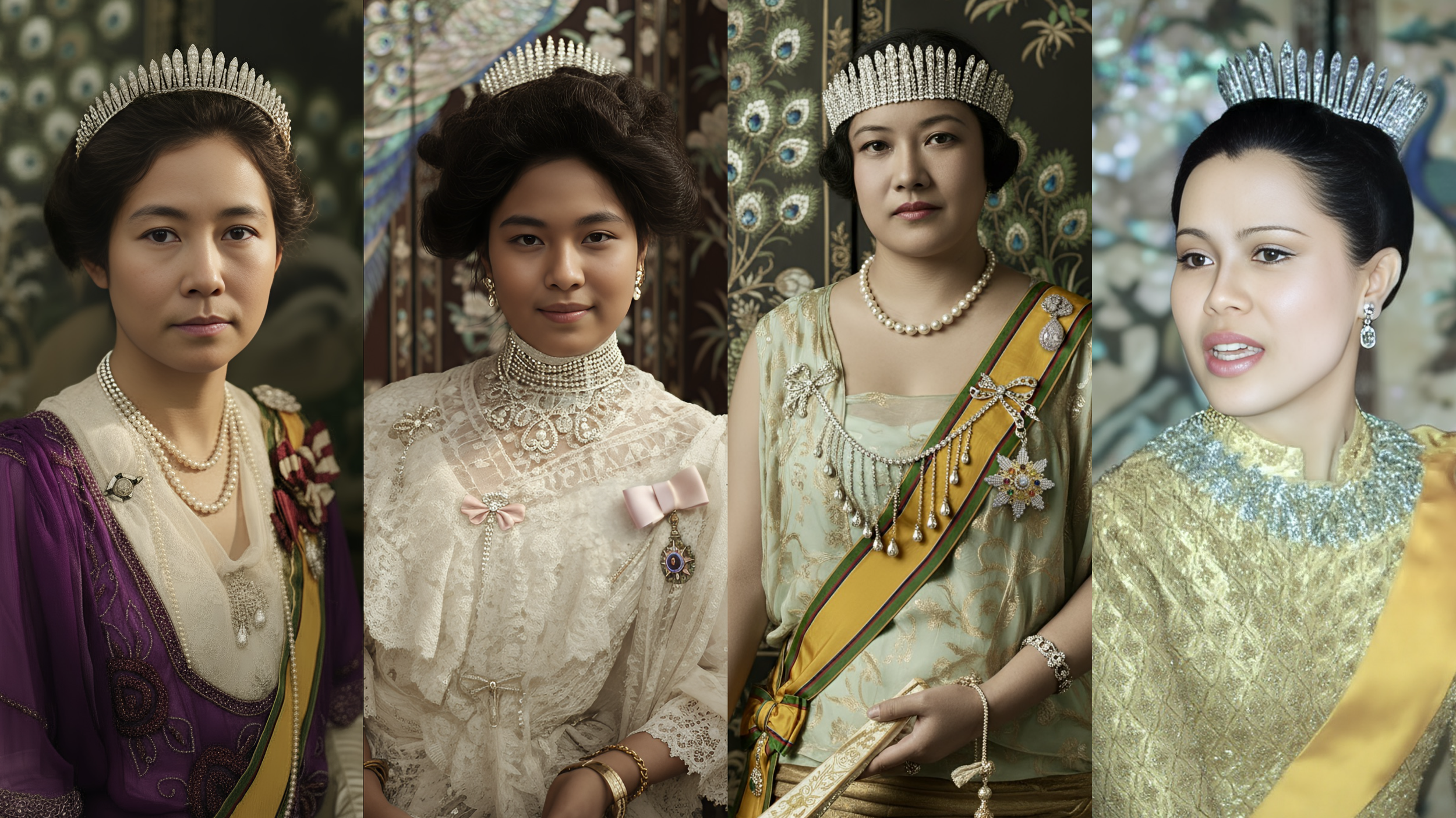เทียร่าประดับเพชรแบบแฉกรัศมี (Fringe Tiara) ของราชสำนักไทย (ตอนที่ ๔)
เทียร่าประดับเพชรแบบแฉกรัศมี (Fringe Tiara) ของราชสำนักไทย (ตอนที่ ๔)
เทียร่าประดับเพชรแบบแฉกรัศมี (Fringe Tiara) หรือที่รู้จักกันในนาม เทียร่าแบบโคโคชนิก (Kokoshnik Tiara) นับเป็นหนึ่งในเครื่องเพชรโบราณที่ทรงคุณค่าที่สุดของราชวงศ์ไทย ด้วยลวดลายซี่เพชรที่เรียงรายราวกับแสงรัศมีแห่งพระอาทิตย์ เทียร่าลักษณะนี้สะท้อนอิทธิพลของแฟชั่นราชสำนักยุโรปในช่วงปลายคริสต์ศตวรรษที่ ๑๙ ได้อย่างเด่นชัด
แรงบันดาลใจของเทียร่าลักษณะนี้มาจากศิราภรณ์ทรงโคโคชนิกของ สมเด็จพระจักรพรรดินีมาเรีย เฟโอโดรอฟนา(Empress Maria Feodorovna) พระราชมารดาใน สมเด็จพระเจ้าซาร์นิโคลัสที่ ๒ แห่งรัสเซีย ซึ่งทรงโปรดศิราภรณ์พื้นเมืองของสตรีรัสเซียที่มีลักษณะครึ่งวงกลม ภายหลังศิราภรณ์ทรงนี้ได้รับความนิยมอย่างสูงในราชสำนักยุโรปยุค เบลเอป็อก(Belle Époque) และได้รับการออกแบบโดยช่างอัญมณีเอกอย่าง แกร์ราด (Garrard) และ คาร์เทียร์ (Cartier) เพื่อถวายแด่ราชวงศ์อังกฤษและราชวงศ์ยุโรปตอนเหนือ
เชื่อกันว่าเทียร่าประดับเพชรแบบแฉกรัศมีนี้เข้ามาสู่ราชสำนักสยามในรัชกาลของ พระบาทสมเด็จพระจุลจอมเกล้าเจ้าอยู่หัว(รัชกาลที่ ๕) พระมหากษัตริย์ผู้ทรงมีพระปรีชาสามารถด้านการทูตและทรงนิยมศิลปะแบบยุโรป พระองค์ได้ทรงจัดหาชุดเครื่องเพชรหลายชุดระหว่างการเสด็จประพาสยุโรปทั้งสองครั้ง และในครั้งที่สองนั้นทรงซื้อเทียร่าลักษณะนี้มาพร้อมโปรดเกล้าฯ พระราชทานให้แก่พระมเหสี พระบรมราชเทวี พระราชเทวี พระอรรคชายา พระราชชายา และเจ้าจอมสดับเมื่อเสด็จนิวัติกลับจากยุโรป โดยเทียร่าองค์ใหญ่ที่สุดได้พระราชทานแก่ สมเด็จพระศรีพัชรินทราบรมราชินีนาถ พระบรมราชชนนีพันปีหลวง ซึ่งนับเป็นหนึ่งในเครื่องเพชรตะวันตกชุดแรก ๆ ที่มีบทบาทสำคัญในราชสำนักสยาม
เทียร่าประดับเพชรแบบแฉกรัศมี (Fringe Tiara) ได้รับการออกแบบอย่างชาญฉลาดให้สามารถปรับเปลี่ยนรูปแบบได้หลายลักษณะ ไม่ว่าจะเป็น แบบบองโด (Bandeau Style), มงกุฎทรงครึ่งวงกลม (Halo Tiara), มงกุฎทรงสูง (Coronet), หรือ สร้อยพระศอเพชรแบบแฉกรัศมี (Diamond Fringe Necklace) อันสะท้อนถึงฝีมือและความประณีตของช่างอัญมณีในยุคนั้น ที่สามารถผสานความงาม ความสง่างาม และประโยชน์ใช้สอยเข้าด้วยกันอย่างงดงาม
หลักฐานการปรากฏของเทียร่าลักษณะนี้ในสยามพบได้ชัดเจนตั้งแต่ปลายรัชกาลที่ ๕ จากภาพถ่ายของ เจ้าจอมหม่อมราชวงศ์สดับ ซึ่งทรงสวมเทียร่าลักษณะเดียวกันนี้ทั้งในรูปแบบสร้อยคอและเทียร่า คาดว่าภาพถ่ายเหล่านี้ถ่ายราวปี พ.ศ. ๒๔๕๐ อีกองค์หนึ่งคือ หม่อมเจ้าประสงค์สม บริพัตร ที่ทรงสวมเป็นสร้อยพระศอปรากฏในพระรูปเมื่อครั้งรับเสด็จ ดยุกและดัชเชสแห่งโยฮันอัลเบร็ชต์ ในปี พ.ศ. ๒๔๕๒ ส่วนผู้ที่ทรงสวมเทียร่าในลักษณะมงกุฎดังเช่น สมเด็จเจ้าฟ้าสุทธาทิพยรัตน์ จากพระรูปที่ทรงฉายในสมัยรัชกาลที่ ๖ รวมถึงในรูปแบบสร้อยพระศอของ พระเจ้าวรวงศ์เธอ พระองค์เจ้าศิริรัตนบุษบง และ แบบสร้อยคอของคุณหญิงรามราฆพ (ประจวบ พึ่งบุญ ณ อยุธยา “สุขุม”)
ต่อมาในทศวรรษ ๑๙๒๐ (พ.ศ. ๒๔๖๐–๒๔๗๐) สมเด็จพระนางเจ้ารำไพพรรณี พระบรมราชินี ใน พระบาทสมเด็จพระปกเกล้าเจ้าอยู่หัว (รัชกาลที่ ๗) ทรงสวมเทียร่าองค์ใหญ่สุดซึ่งเป็นพระราชมรดกจากสมเด็จพระศรีพัชรินทราบรมราชินีนาถ ในลักษณะ มงกุฎคาดพระเศียรแบบบองโด (Bandeau-style Tiara) ซึ่งเป็นสไตล์ยอดนิยมแห่งยุค อาร์ตเดโค (Art Deco) ในพระราชพิธีบรมราชาภิเษก พ.ศ. ๒๔๖๘ (ค.ศ. 1925) พระฉายาลักษณ์จากพระราชพิธีครั้งนั้นเผยให้เห็นพระสิริโฉมอันสง่างามของพระบรมราชินีผู้ร่วมสมัย พระเกศาทรงบ็อบและฉลองพระองค์แบบตะวันตกเข้ากันได้อย่างงดงามกับประกายเพชรของเทียร่าองค์นี้
ภายหลังสิ้นสุดรัชกาลที่ ๗ เทียร่าองค์นี้ได้กลายเป็นหนึ่งในเครื่องเพชรที่สืบทอดอยู่ในคอลเลกชันของราชวงศ์จักรี และได้รับการนำกลับมาใช้ใหม่ในฐานะ สร้อยพระศอเพชรแบบแฉกรัศมี โดย สมเด็จพระเจ้าภคินีเธอ เจ้าฟ้าเพชรรัตนราชสุดา สิริโสภาพัณณวดี และภายหลังโดย สมเด็จพระนางเจ้าสิริกิติ์ พระบรมราชินีนาถ พระบรมราชชนนีพันปีหลวง ทำให้เทียร่าองค์นี้ยังคงได้รับการยกย่องว่าเป็นหนึ่งในเครื่องเพชรที่ทรงคุณค่าและเก่าแก่ที่สุดในราชวงศ์ไทยมาจนถึงปัจจุบัน
เทียร่าประดับเพชรแบบแฉกรัศมีจึงเปรียบเสมือนสัญลักษณ์แห่ง “ยุคสมัยใหม่ของราชสำนักสยาม” ที่หลอมรวมความสง่างามแบบไทยเข้ากับศิลปะแห่งตะวันตกได้อย่างลงตัวและทรงคุณค่า เป็นเครื่องหมายแห่งการผสานระหว่าง “พระเกียรติยศ ความงาม และวัฒนธรรมสยามที่เชื่อมโยงกับโลกตะวันตก” ได้อย่างสง่างามเหนือกาลเวลา
The Diamond Fringe Tiara of the Thai Royal Court (Part IV)
The Diamond Fringe Tiara, also known as the Kokoshnik Tiara, is among the most treasured historic jewels of the Thai royal family. Its design, composed of evenly spaced diamond spikes radiating like the sun’s rays, vividly reflects the influence of late nineteenth-century European court fashion.
The design of this tiara was inspired by the traditional Russian kokoshnik headdress favoured by Empress Maria Feodorovna, mother of Tsar Nicholas II of Russia. The empress admired the semi-circular form of native Russian women’s headpieces, and in time this silhouette became highly fashionable across European courts during the Belle Époque era. Renowned jewellers such as Garrard and Cartier adapted the design for the royal houses of Britain and northern Europe, creating exquisite diamond tiaras in the kokoshnik style.
It is believed that the Fringe Tiara was introduced to the Siamese court during the reign of King Chulalongkorn (Rama V), a monarch celebrated for his diplomatic acumen and his appreciation of European art and craftsmanship. During his two grand tours of Europe, the King acquired several suites of diamonds and precious jewels. On his second journey he is thought to have purchased this particular tiara, later bestowing similar ornaments upon his consorts — the Queen, Royal Consorts, and Chao Choms Sadab — upon returning to Siam. The largest and most magnificent of these tiaras was presented to Queen Sri Bajarindra, the Queen Mother, marking one of the earliest Western diamond parures to play a prominent role in the Siamese court.
Ingeniously designed, the Fringe Tiara could be worn in several forms: as a bandeau, a halo-shaped crown, a coronet, or as a diamond fringe necklace. This versatility exemplifies the refined artistry and technical mastery of the jewellers of that era, blending beauty, elegance, and practicality in perfect harmony.
Evidence of this style’s presence in Siam can be traced to the late reign of King Chulalongkorn. Archival photographs show Chao Chom M.R. Sadab wearing a similar piece both as a necklace and as a tiara, likely around 1907 (2450 BE). Another royal lady, M.C. Prasongsom Paribatra, was photographed wearing the piece as a necklace during the reception of the Duke and Duchess of Johann Albrecht in 1909 (2452 BE). A version worn as a tiara appears to have been used by Princess Suddha Dhipyaratana in the reign of King Vajiravudh (Rama VI), while necklace forms were later seen on H.H. Princess Siriratana Busabong and Khunying Ramarakop (Prajoub Phuengbun na Ayudhya “Sukhum”).
During the 1920s (2460–2470 BE), Her Majesty Queen Rambhai Barni, consort of King Prajadhipok (Rama VII), wore the grand Fringe Tiara inherited from Queen Sri Bajarindra as a bandeau-style tiara, a fashionable Art Deco interpretation of the design. In portraits taken for the 1925 Coronation, the Queen’s modern bobbed hairstyle and Western gown harmonised beautifully with the tiara’s brilliance, embodying the refined sophistication of the era.
After the end of King Prajadhipok’s reign, the tiara became part of the Chakri Dynasty’s royal jewellery collection and was later worn as a diamond fringe necklace by H.R.H. Princess Bejaratana Rajasuda Sirisobhabannavadi and subsequently by Her Majesty Queen Sirikit, The Queen Mother. The tiara remains today one of the most valuable and historically significant jewels of the Thai monarchy.
Thus, the Diamond Fringe Tiara stands as a symbol of the “modern era of the Siamese court,” a perfect synthesis of Thai grace and Western artistry. It embodies a timeless union of royal dignity, beauty, and cultural dialogue between Siam and the West, shining with enduring splendour through the ages.
#aifashionlab #AI #aiartist #aiart #aifashion #aifashiondesign #aifashionstyling #aifashiondesigner #fashion #fashionhistory #historyoffashion #fashionstyling #fashionphotography #digitalfashiondesign #digitalcostumedesign #digitaldesign #digitalaiart #ThaiFashionHistory #ThaiFashionAI #thailand
























